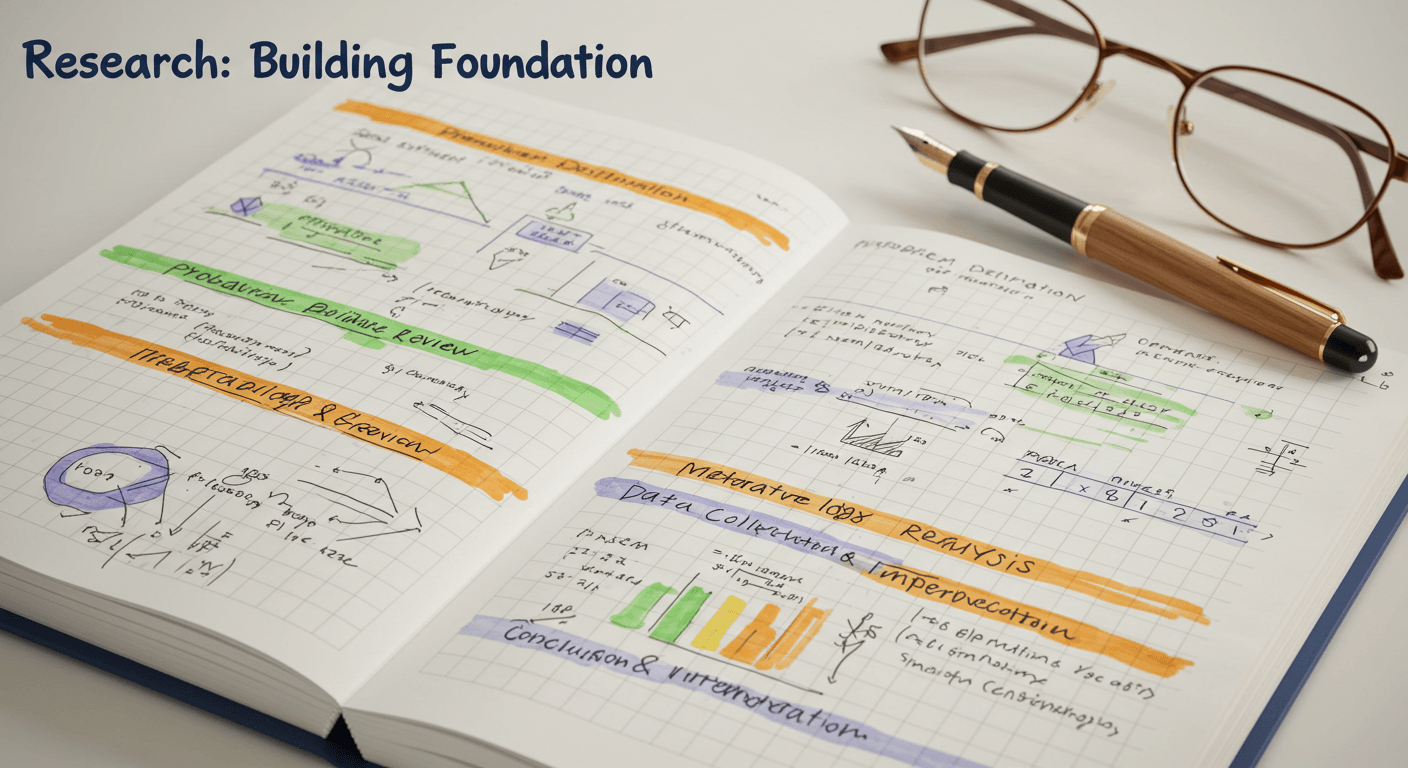The Complete Guide to YouTube Scriptwriting: From Beginner to Expert
Master the art of YouTube scriptwriting with this comprehensive system that's generated millions of views and dollars
YouTube scriptwriting isn't just about putting words on paper - it's about crafting an experience that captivates viewers from the first second to the final call-to-action.
After working with top educational YouTubers and analysing hundreds of hours of content, I've distilled the essential elements that separate amateur scripts from viral hits.
Think of YouTube scriptwriting like building a captivating house. Every element serves a purpose: research lays the foundation, hooks create curb appeal, payoffs are the comfortable rooms that reward exploration, and seamless transitions guide visitors through each space.
Let's dive into the complete system that will transform your content creation.

Research: Building Your Foundation
Research is where most creators fail - not because they don't do it, but because they do it wrong.
They either spend too much time diving down rabbit holes, don't know when to stop, or worse, research poorly and create content that's already been done to death.
The Four Pillars of Effective Research
Audience Understanding:
Know what your viewers need, want, and care about.
This isn't just demographics - it's understanding their pain points, aspirations, and the language they use.
Competitor Analysis:
Study the landscape.
What's working? What gaps exist? What trends are emerging in your niche?
Content Gathering:
Collect facts, examples, and unique insights that add genuine value.
This is your ammunition for creating superior content.
Validation:
Double-check everything.
Accuracy builds trust, and trust builds audiences.
Finding the Perfect Video Length
Length isn't arbitrary - it should match your content's value density:
Short (2-5 minutes): Quick tips or entertainment. Perfect for bite-sized value without detailed explanations.
Medium (6-12 minutes): Tutorials and how-tos. Deliver 3-5 main points with actionable details while staying concise.
Long (12+ minutes): Deep dives and comprehensive guides. Justify every minute with high-value content—no fluff allowed.
The Content Gap Strategy
Here's the secret:
Don't just research what exists - research what's missing.
Watch the top 3-5 videos in your niche, document their key points, then ask: "What are they not covering?"
Look at comments for complaints, questions, and requests.
These gaps are your goldmine for standout content.
The Video Grading System
Spend 15 minutes evaluating competitor videos across these criteria:
Insight: How original and actionable is the information?
Hooks: Do the opening seconds grab attention immediately?
Pacing: Is the rhythm engaging or does it drag?
Tonality: Does the energy match the content and audience?
Storytelling: Are narratives clear and compelling?
Editing: How professional and seamless are the visuals?
Rate each area 1-3 and identify specific elements you can improve upon.

Hooks: Your Make-or-Break Moment
You have less than 30 seconds before viewers decide to stay or leave.
A powerful hook can achieve 40-50% retention in those crucial first moments.
The Anatomy of a Perfect Hook
Every effective hook accomplishes four things:
Confirms expectations: Validates that they didn't get clickbaited
Introduces curiosity: Teases a story, solution, or surprising result
Sets stakes: Shows why this matters to them personally
Establishes uniqueness: Differentiates your content from the crowd
Common Hook Killers
Excessive jargon: Keep language accessible, especially in the opening
Overexplaining: Cut the fluff and deliver value immediately
Credential overload: One relevant line of authority is enough
Generic openings: "In today's video, we're going to talk about..." is instant death
Hook Types That Work
The simplest hooks are often the most effective.
Whether you use a shocking statement, compelling question, or personal story, remember:
Your title raises questions in viewers' minds, and your hook should start answering them immediately.

Payoffs: Delivering the Dopamine Hit
A payoff is the moment when viewers think, "This is why I watched!"
It's your reward for their attention - the dopamine hit that makes them feel their time was well spent.
Setup and Payoff: The Dynamic Duo
Every payoff needs a setup.
You can't just drop valuable information randomly - you need to create anticipation.
Plant clear, simple setups that explain why viewers should care, then deliver logical, well-prepared payoffs that feel earned.
Types of Payoffs
Emotional payoffs: Make viewers feel something - joy, relief, inspiration, even fear when appropriate
Informational payoffs: Reveal knowledge they came seeking, with depth that exceeds expectations
Timing Is Everything
Deliver payoffs too early and you lose impact.
Too late and you lose the audience.
Build gradually with smaller moments while building toward your major payoff.
Keep sections to 300-500 words - longer sections might need mini-payoffs to maintain engagement.
Open Loops: The Art of Strategic Curiosity
Open loops are your secret weapon for retention.
They create unresolved tension that compels viewers to keep watching.
Master this technique and watch your retention rates soar.
The Four-Step Open Loop Framework
Start with curiosity: What unresolved question will keep viewers engaged?
Build tension: Create enough intrigue without revealing the answer
Strategic delay: Layer multiple open loops throughout your video
Always close the loop: Every promise must be fulfilled by the end
Common Open Loop Mistakes
Being too vague ("You won't believe what happens next!")
Resolving loops too quickly and killing tension
Forgetting to close loops, which breaks trust with your audience
Study creators like MrBeast or Ali Abdaal.
Notice how they introduce questions, maintain curiosity, and strategically reveal answers to keep viewers glued to their screens.
Call to Actions: Converting Viewers to Customers
Your CTA determines what happens after someone finishes your video.
This moment can multiply your impact exponentially or waste all the goodwill you've built.
The Timing Philosophy
For videos under 40 minutes, focus on directing viewers to your next piece of content rather than hard-selling products.
This creates a "spiderweb effect" - increasing session time and signalling to YouTube's algorithm that your content keeps people engaged.
For longer content where you've delivered massive value, a soft product pitch feels natural and earned.
The Hook-Curiosity-Action (HCA) Framework
Keep end-screen CTAs under 100 words:
Hook: Grab attention just as they think the value is over
Curiosity: Introduce a new problem your next video solves
Action: Give specific instructions for what to do next
This framework dramatically increases click-through rates and generates "free views" that compound your growth.
Editing: Polishing Your Diamond
Your first draft is for dumping ideas.
Editing transforms those ideas into a coherent, compelling narrative that can cut your writing time in half while doubling your quality.
The POWER Method
P - Pause:
Take a break after your first draft to return with fresh eyes
O - Out loud test:
Read your script aloud to catch awkward phrasing and unnatural flow
W - Work with tools:
Use Grammarly, Claude, or Hemingway to improve readability (aim for 5th-7th grade reading level)
E - Evaluate flow:
Ensure each sentence logically leads to the next. Cut filler words that don't contribute value
R - Record your check:
Record yourself reading the script and watch it back to catch delivery issues
Section-Specific Editing
Hooks: Validate title/thumbnail promises and create clear curiosity gaps
Body: Deliver actionable value with smooth transitions and compelling examples
Outro: Single, clear CTA linked to your content with promised transformation
Storyboarding: Your Editor's Roadmap
Storyboarding means adding visual notes for your editor -essentially "pre-editing" that saves time, reduces revisions, and creates more engaging videos.
The VRCT Framework
V - Visuals: Notes for transitions, effects, and visual style
R - References: Links to inspiration videos or images
C - Clips: Specific footage to include
T - Time codes: Precise timestamps for when effects should happen
Storyboarding Best Practices
Keep notes concise but specific.
"Make it better" helps no one, but "fade to black with echo effect at 2:34" gives clear direction.
Always respect copyright - use licensed clips and royalty-free resources.
AI: Your Scriptwriting Assistant
AI isn't replacing human creativity - it's amplifying it.
But to use AI effectively, you must first understand what good scripts look like and know the right questions to ask.
Essential AI Tools
Perplexity: Excellent for research and deep dives into new topics
Claude: Superior for writing and understanding brand voice nuances
AI Use Cases That Work
Brand Voice Extraction: Feed AI your existing content to create a "voice profile" that maintains consistency across all scripts
Objective Editing: Use AI as a "third eye" to spot weaknesses and suggest improvements based on proven frameworks
Putting It All Together
Mastering YouTube scriptwriting is like conducting an orchestra - every element must work in harmony.
Your research provides the sheet music, hooks grab the audience's attention, payoffs deliver emotional crescendos, open loops maintain engagement, CTAs direct the next movement, editing polishes the performance, storyboarding guides the visual symphony, and AI helps you compose faster and more effectively.
The goal isn't just to create content - it's to create experiences that transform viewers, build communities, and drive meaningful results for your business or mission.
Remember: great scripts aren't written, they're rewritten. Start with this framework, practice consistently, and refine based on your analytics. Your audience will tell you what's working through their engagement, retention, and actions.
The difference between amateur and professional YouTube scripts isn't talent - it's system. Now you have the system.
The only question left is: what will you create with it?
If you have any questions or need further information, please email us at rachel@earnwithdesign.com

